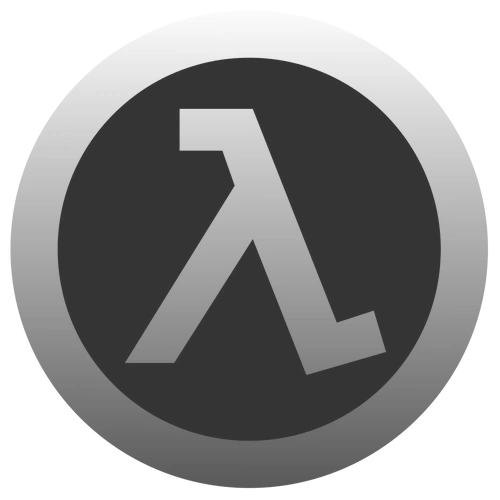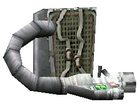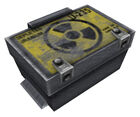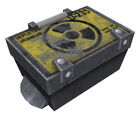| To illustrate the article add one or more relevant images or upload them from canonical / official sources. For more instructions visit Half-Life Wiki:Images. |
- "I just can't bring myself to use it on a living creature. You don't seem to have trouble killing things."
- ―Black Mesa Scientist[src]
The Gluon Gun, or Quantum Destabilizer, is an experimental weapon which fires a glowing beam of energy capable of vaporizing mostly everything it hits.
Overview
The Gluon Gun was discovered by Gordon Freeman at the Black Mesa Research Facility's Lambda Complex, where it was developed. Unwilling to use it on living creatures, the designer of the gun deems Gordon less hesitant to kill and gives the gun to him.
The gun consists of a hand-held beam emitter attached by a thick cable to a backpack-mounted unit. The name Gluon Gun comes from namesake gluon particles. Gluons are particles that mediate the strong nuclear force that holds atomic nuclei together; whether the Gluon Gun actually fires streams of gluons or instead interferes with the gluons already present in an object is unclear, but in either case the weapon interferes with the fundamental interactions of matter. In the game, the stresses caused by this reaction can blast almost any living creature to pieces.
Tactics
The Gluon Gun is useful against Xen Creatures that cannot be damaged with bullets (such as the Gargantua), as the beam fires continually, scoring multiple hits while striking through armor.
Multiplayer
- In multiplayer, the Gluon Gun is generally a poor weapon of choice. Latency issues cause the beam to lag; players may have to hold down the attack button for a time before the beam actually fires. Also, the gun has a tendency to lag behind players it is pursuing. However, this generally only applies to old versions of Half-Life, as the Steam version uses lag compensation.
- At long ranges it is more useful as the beam doesn't bend as sharply as it does at closer ranges, therefore improving its overall maneuverability.
- Some servers enhance the damage done per ammo point when fired to make it more useful. Players with low ping will likely benefit most using this weapon.
- Compared to single-player, the Gluon Gun drains ammo slower, and damage is also dealt to everything near the beam's target.
Behind the scenes
- The Gluon Gun was originally to have two fire modes: a wide beam and a thin beam. These would be toggled between by turning the handle 90 degrees. While this feature was cut, the model still possesses the animations for moving the handle. There are also damage settings for both beams in the game configuration files.
Trivia
- The weapon is sometimes called the "Egon gun", as many of the game files refer to it as such. It bears a strong similarity to the Proton Packs used by characters from the 1984 film Ghostbusters. One of the main characters is a scientist named Egon Spengler, hence the name used within the game files.
- The Flamethrower in Team Fortress Classic uses a modified version of the Gluon Gun's model.
- Pressing the secondary attack key causes the view model to randomly play an idle animation once, then freeze. Releasing the key will stop the animation and return to normal. Other weapons lacking secondary fire modes such as the Shock Roach also experience this glitch. However, in Half-Life: Opposing Force, pressing the secondary attack key will make the Gluon Gun attack exactly the same as its primary attack.
- In multiplayer, the Gluon Gun can penetrate walls, ceilings, and floors. However, doing so can only lightly damage the suit power of the targeted player.
- The design of the Gluon Gun has a slight resemblance to the design of a prototype ASHPD as seen on a poster in the old Aperture Science.
- In Half-Life: Opposing Force, the player can obtain the Gluon Gun by using cheats.
- The name of the gun is derived from "gluon", which is the exchange particle of the strong force in physics. The strong force is responsible for particles made up of quarks (i.e. hadrons), e.g. the neutron and the proton, to form stable systems. It further is also responsible for the formation of atomic nuclei. Essentially the name gluon is just derived from the word "glue".
Gallery
List of appearances
- Half-Life (First appearance)
- Half-Life: Opposing Force (Multiplayer only)
- Half-Life: Blue Shift (Game files only)
- Half-Life: Source
- Half-Life Deathmatch: Source (Non-canonical appearance)
- Black Mesa (mod) (Non-canonical appearance)
References
- ↑ Stephen Bahl as quoted on Marc Laidlaw Vault on the HalfLife2.net Forums








